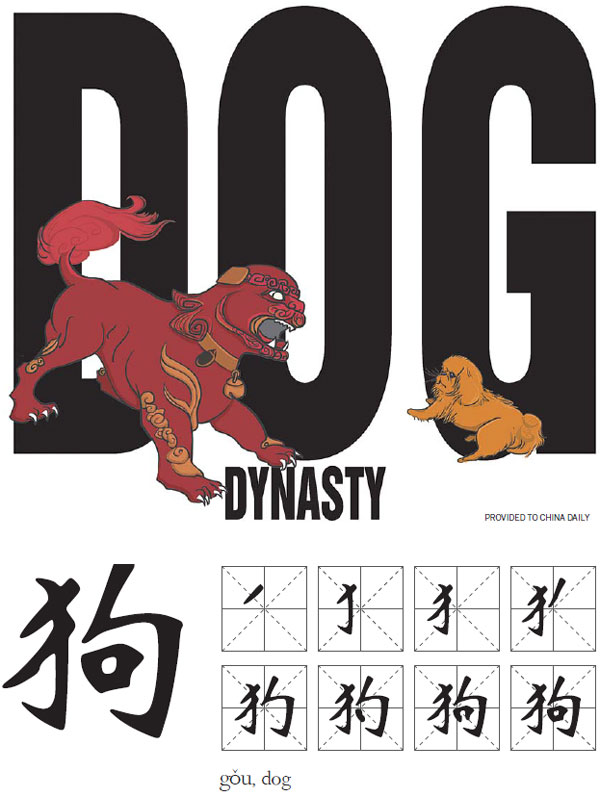Days of the dog
Updated: 2015-07-31 08:30
By David Dawson(China Daily Europe)
|
|||||||||||
DNA studies suggest domestication happened south of the Yangtze River up to 15,000 years ago
DNA证据显示,人类和狗最早的友谊很可能发源于长江以南
Be it a yapping shihtzu or a lumbering Tibetan mastiff, dogs have always been man's best friend - or have they?
Technically, at some moment in history, there was a point when man and dog were first united. But scientists are divided on how this union came about.

One prominent academic, Peter Savolainen, from the Swedish KTH Royal Institute of Technology, has for over a decade claimed that the origins of the domestic dog lay in a region of China or Southeast Asia, south of the Yangtze River.
Essentially, there are a few ways scientists can trace the origins of a domesticated species. Archaeological research was the primary method for some time. However, in the past few decades, as the science of DNA has become more sophisticated, analyzing DNA for clues has become more applicable.
But how does that work exactly? It's not as if the DNA has a "Made in China" tag. Rather it is the absence of DNA that makes the case.
Savolainen points out that his research revolved about 10 DNA types, three of which were found only within this region.
"The only place you can expect to find all 10 types is at the point of origin," he says. "You have 10 basic types among dogs. You have all the types in southern China and Southeast Asia. As soon as you go north of the Yangtze River you find only seven. In Northeast China, in Heilongjiang province, we found only five; in Japan, we found seven; in Europe, four."
But when he talks about these DNA types, it is crucial to avoid associating this with the idea of various varieties of dog.
"In this case, the DNA doesn't code for any genes. It is random junk DNA in a way. That's the perfect thing for looking at this kind of analysis, otherwise there might be selection. These don't carry a function."
In a number of papers in recent years, Savolainen and co-authors have made the case that the genetic diversity of dogs in this region south of the Yangtze River indicated that this was the cradle of dog-human civilization, with the first domestication of dogs occurring somewhere between 5,400 and 16,300 years ago.
The wide window is due to the fact that, while using DNA is handy for determining the origin point of a domesticated species like this, it is not ideal for determining the exact period - archaeology is needed in those cases.
Given the results of archaeological findings, Savolainen estimates that the domestication event probably happened between 10,000 and 15,000 years ago.
The DNA also cannot specifically explain the means by which the animals spread, although Savolainen said it was likely to have been trade, if the animals proved popular. But before this domestication can be notched up to another made-in-China success, it is probably wise to point out that, according to Savolainen's best guess, the dogs may well have been raised for food - a finding that perhaps reinforces certain unpalatable stereotypes.
Given the transition into agriculture in the area at the time, it seems likely that food was a primary reason for this domestication.
Savolainen first started researching this area after he noticed during forensic analysis of dog hairs from a crime scene in 1999 that dogs from East Asia had their own unique genetic differences.
He got in touch with professor Zhang Yaping in China for assistance in locating samples, and began working with Zhang and professor Wang Guodong, who operate out of the State Key Laboratory of Genetic Resources and Evolution, and the Yunnan Laboratory of Molecular Biology of Domestic Animals, under the Chinese Academy of Sciences' Kunming Institute of Zoology.
Since then, across various studies, the scientists have collected 3,000 dog samples from around the world, including 500 from China. They hope to more precisely identify where dogs originated, and also identify the specific genes that changed in the evolution from wolves to dogs.
Interestingly, according to DNA evidence, dogs are not the only animals that appear to have been domesticated in China. Pigs seem to have two different origin points - one in the Middle East, one in China. Genetic evidence also shows that chickens were domesticated in a similar region to dogs, somewhere south of the Yangtze River, either in China or Southeast Asia.
However, there are alternative theories circulating throughout the scientific community. A study published in Nature magazine that also used DNA evidence and archaeological findings puts the point of origin for the domestic dog in the Middle East. This is more in line with previous theories, which relied solely on archaeological evidence, but Savolainen points out that this study did not include samples from the region of Asia where this genetic diversity was found.
Issues relating to the number of DNA samples collected from various regions represent some of the key difficulties in analyzing the origins of dogs; some areas have been sampled extensively, while others are left almost untouched.
This not only creates gaps in knowledge, but can also lead to bias as researchers develop assumptions. In addition, distinguishing between wolf bones and dog bones can be a highly specialized task, which can also easily result in wolves being incorrectly identified as dogs.
The findings of this research into dog domestication also have some other intriguing ramifications. This would mean that certain wild dogs in far-flung locations, such as the Australian dingo, made their way to these locations from Asia after a period of domestication, and then went wild once again. As the only mammal with a placenta (aside from humans) that existed on the continent prior to European colonization, the dingo has drawn significant interest from scientific circles.
A 2004 paper, also involving Savolainen, determined that it was likely that people brought a small group of dogs from Southeast Asia to Australia sometime around 5,000 years ago.
Whether the dog was destined for the dinner plate or companionship, it is possible ancient Chinese farmers were responsible for the first generations of man's best friend.
Either way, it is certainly food for thought.
Courtesy of The World of Chinese, www.theworldofchinese.com
The World of Chinese
(China Daily European Weekly 07/31/2015 page27)
Today's Top News
Beijing makes it, again!
Probable MH 370 debris to be studied in Toulouse
Graft probe into Guo Boxiong to win army, public's support
SOE reform to open door to foreign capital
Effect of Chinese stock volatility on real economy limited
Chinese tea aims to go global on Belt and Road Initiative
Sino-Turkish links highlighted
Debris found off Africa linked with Flight MH370
Hot Topics
Lunar probe , China growth forecasts, Emission rules get tougher, China seen through 'colored lens', International board,
Editor's Picks

|

|

|

|

|

|






